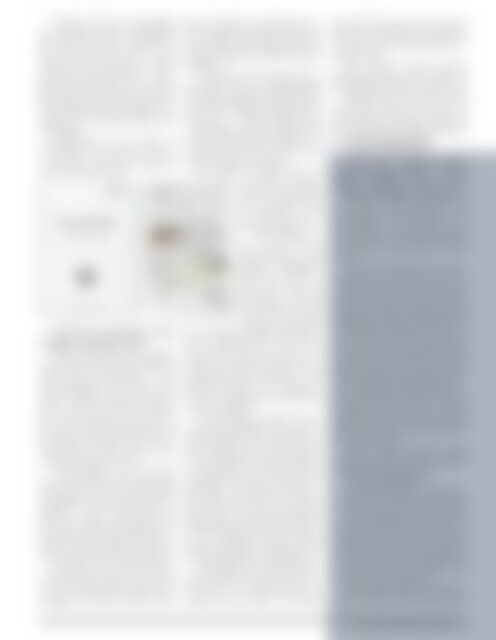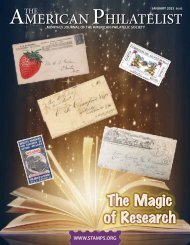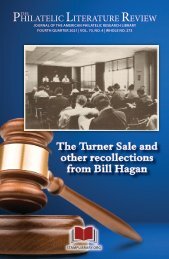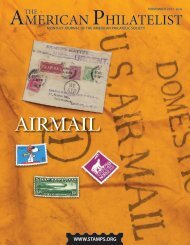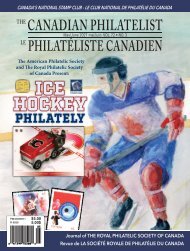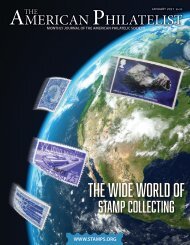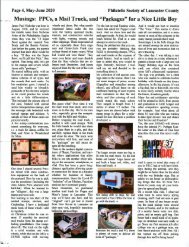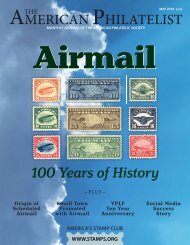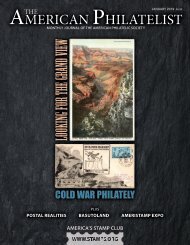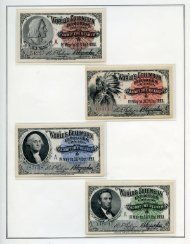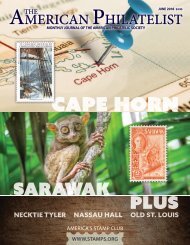August 2018 - Sneak Peek
The American Philatelist is the monthly journal of the American Philatelic Society, the world's largest organization for stamp collectors and enthusiasts. Members receive the printed magazine and can access the digital edition as a benefit of membership in the Society. Please enjoy this sneak peek. We're confident that once you see all that we offer, you'll want to join the APS today.
The American Philatelist is the monthly journal of the American Philatelic Society, the world's largest organization for stamp collectors and enthusiasts. Members receive the printed magazine and can access the digital edition as a benefit of membership in the Society. Please enjoy this sneak peek. We're confident that once you see all that we offer, you'll want to join the APS today.
Create successful ePaper yourself
Turn your PDF publications into a flip-book with our unique Google optimized e-Paper software.
The plot, though, was well thought<br />
out, including a smart technological<br />
twist that was meant to help the evil<br />
Nazi stamp thief recover the stolen<br />
stamps. (Oh, yes, the stamps – they’re<br />
out there somewhere!) Also, a showdown<br />
between hired guns and a badly<br />
beaten Harry Strong atop a skyrise under<br />
construction has a near-genius conclusion<br />
that I wished had lasted several<br />
more pages.<br />
Self-published by the author in<br />
<strong>2018</strong>. Softcover, 6¾ inches by 9½ inches,<br />
363 pages. $16.95, plus shipping on<br />
Amazon; $4.99 for Kindle.<br />
Canal Zone Airmail Rates, by Tom<br />
Brougham and Bradley White<br />
Don’t be fooled by the minimalist<br />
cover of this slick, book. The insides are<br />
packed with vital information – fullcolor<br />
examples of Canal Zone covers<br />
carried via different rates, plus text and<br />
tables – that try to present the “definitive”<br />
work of airmail to and from this<br />
tiny sliver of land (20 miles wide across<br />
the Isthmus of Panama) that the U.S.<br />
controlled from 1903 to 1979. Airmail<br />
service ran from 1924 to 1979.<br />
“This handbook covers all postal<br />
rates used on Canal Zone mail receiving<br />
any airmail service to all destinations<br />
worldwide,” the Introduction states. “In<br />
addition to classic airmail-all-the-way<br />
service for letters and postcards, this<br />
work explains and lists all possible combination<br />
rates providing for partial air<br />
service and the rates for parcel airmail.”<br />
OK, that’s a lot to cover, but this is<br />
a tiny little place. Really, how complex<br />
can this be? Stick some stamps on a<br />
package and off it goes, right? A quick<br />
glance through this handbook heavily<br />
crammed with numbers, denominations,<br />
weights, rates and places gives you<br />
a glimpse of just how complex an area of<br />
study this is.<br />
Come to find out, sending a letter or<br />
parcel back to the U.S. mainland might<br />
be relatively simple. But what about the<br />
rest of the world? Mail could acquire different<br />
costs – therefore different rates<br />
– depending not only by weight, but by<br />
country, continent and hemisphere, not<br />
to mention by what year or carrier, zeppelin<br />
vs. airplane, for example.<br />
The result is a massive amount of<br />
work that was undertaken<br />
and accomplished<br />
by the authors, who<br />
were helped by members<br />
of the study unit.<br />
“The backbone of<br />
this work is 39 rate<br />
tables detailing several<br />
hundred distinguishable<br />
Canal Zone airmail<br />
rates,” states the<br />
Introduction. “In addition<br />
to well-known and<br />
frequently seen airmail<br />
rates, the tables, narratives and illustrations<br />
methodically delve into obscure<br />
corners of the topic, and even occasionally<br />
into areas where information is<br />
sparse and consensus is lacking. … This<br />
handbook stretches to be comprehensive.”<br />
The only thing not presented are<br />
special event flights.<br />
The Introduction includes an overview<br />
and terminology and a guide to<br />
determining the rates of airmail covers<br />
and is followed by six more chapters:<br />
To the United States and Other Domestic<br />
Destinations; To Foreign Western<br />
Hemisphere Destinations; Partial Airmail<br />
Service to Transoceanic Destinations;<br />
Full Airmail Service via Transatlantic<br />
Routes to or Beyond Europe and<br />
Mediterranean Africa; Full Airmail Service<br />
via Transpacific Routes to Pacific<br />
Islands, Australasia, Asia and Sub-Saharan<br />
Africa; plus Sources and Resources.<br />
The handbook was created via documents<br />
from the Canal Zone Postal Service<br />
and the U.S. Postal Service; contemporary<br />
press reports; two volumes<br />
by Anthony Wawrukiewicz and Henry<br />
Beecher on domestic and international<br />
U.S. postal rates; and thousands of Canal<br />
Zone covers.<br />
This is clearly a must for anyone<br />
delving into this area. Not a member of<br />
the study group? Maybe it’s time to join.<br />
Published by the Canal Zone Study<br />
Group, <strong>2018</strong>. Softcover, 8½ inches by 11<br />
inches, 86 pages; included in study group<br />
membership; $25 plus shipping otherwise<br />
from czgsecretary@gmail.com.<br />
2019 Scott Standard Postage<br />
Stamp Catalogue, Volume 3 in two<br />
books; G countries in Vol. 3A and<br />
countries H through I in Volume 3B<br />
Volume 3 of the 2019 Scott Standard<br />
Postage Stamp Catalogue – the<br />
175th edition – was released June 1<br />
and continues with images of stamps<br />
showing trains and locomotives on the<br />
covers.<br />
Each book duplicates the basics,<br />
starting with an Introduction that includes<br />
contact info for societies, study<br />
groups and expertizing services, plus<br />
an illustrated guide to grading, catalog<br />
listing policy, a guide to the listings and<br />
color and general abbreviations. A section<br />
covers basic stamp information,<br />
from paper and watermarks to printing<br />
processing, inks, luminescence, gum,<br />
fakes and forgeries, terminology, common<br />
design types (illustrated) and currency<br />
conversion. For the British Commonwealth<br />
collector there is a listing<br />
of British Commonwealth nations and<br />
guides to dies and watermarks of British<br />
colonial stamps.<br />
Here is a look at Volume 3, which<br />
weighs 6 pounds, 13.6 ounces altogether,<br />
just about equally divided:<br />
Vol. 3A: G Countries<br />
The 2019 Volume 3A has 904 pages,<br />
plus 56 pages of introductory material.<br />
First, a couple of short notes about<br />
two of this volume’s most popular collecting<br />
countries, Germany and Great<br />
Britain, both of which are extensively<br />
covered by popular catalogs published<br />
in their own countries, Michel and<br />
Stanley Gibbons, respectively.<br />
For the basic collector, Scott offers a<br />
pretty extensive look at both countries.<br />
AUGUST <strong>2018</strong> / AMERICAN PHILATELIST 787


